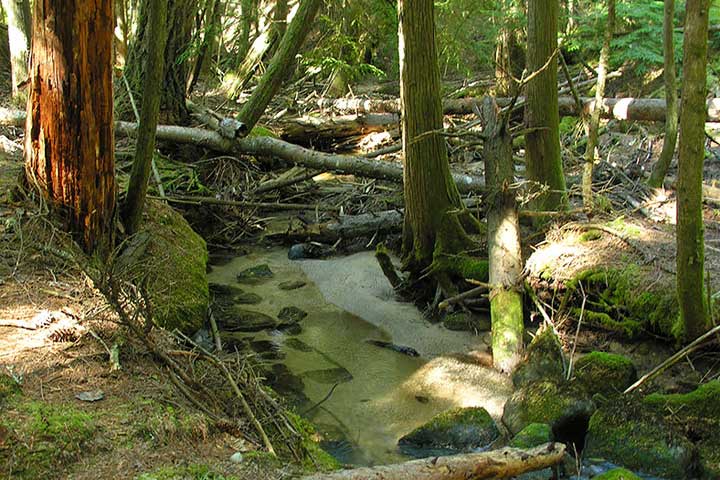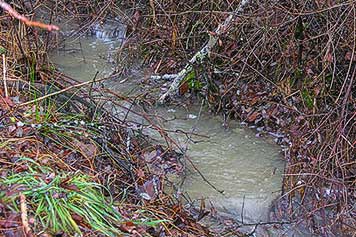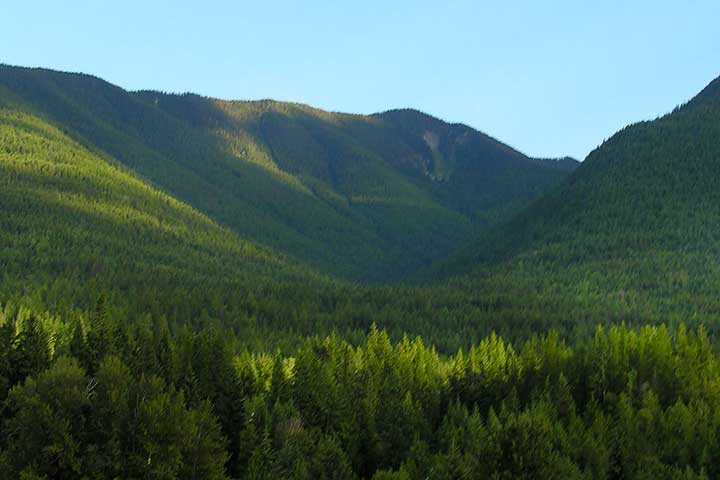The source of beach sand
When a child, I used to row to Troup and hike up Five-mile Creek. It struck me as odd that the creek bed, high above the Lake, was sandy: how, I wondered, did the sand get up there from the lakeside beaches against the flow of the creek water? It made no sense to me—as well it should not—for the movement actually went the other way! It is the creeks which are the source of virtually all of the sand for the beaches around Kootenay Lake.
Kootenay Lake is in the interior wet belt: its surrounding mountains, the Selkirks and Purcells, are heavily forested, and have a substantial snowfall in the winter and rainfall in the summer. The Lake is fed by rivers—Kootenay, Duncan, Kaslo—many big creeks, such as Kokanee and Coffee, and hundreds and hundreds of tiny ones. The flowing waters of each of these moves sand to the lakeshore, with the largest input probably occurring during the spring runoff.
But, the beaches are rarely coincident with the creek mouth; they are merely in the vicinity. Thus, the spectacular sand of Five-mile Point is a few hundred meters removed from the mouth of Five-mile Creek. The sand is moved that distance by a process known as longshore drift.
 Sand lies along the bed of Tunstall Creek. It has been washed down from higher in the mountains, and with the next vigorous flow, whether caused by a heavy rain or a spring runoff, this sand will be washed closer to the lakeshore, ultimately to add to the beaches at Seven-mile Point. This process is repeated many times through the year in hundreds of creeks, all feeding the beaches of the Lake.
Sand lies along the bed of Tunstall Creek. It has been washed down from higher in the mountains, and with the next vigorous flow, whether caused by a heavy rain or a spring runoff, this sand will be washed closer to the lakeshore, ultimately to add to the beaches at Seven-mile Point. This process is repeated many times through the year in hundreds of creeks, all feeding the beaches of the Lake.
 Following a good rainfall, the increased flow of this small unnamed creek makes it turbid with the sand it is carrying down the mountainside.
Following a good rainfall, the increased flow of this small unnamed creek makes it turbid with the sand it is carrying down the mountainside.
 The same little creek as seen in the picture to the left enters the Lake and dumps its sand, which then adds to the beach. This is repeated at hundreds of little creeks around the Lake.
The same little creek as seen in the picture to the left enters the Lake and dumps its sand, which then adds to the beach. This is repeated at hundreds of little creeks around the Lake.
 Large and small creek valleys extend sideways from the Lake into the mountains. This valley was carved by Procter Creek. The material which has been eroded from the mountainside by the creeks has been carried down to form a delta extending into the Lake. Thus the town of Procter is built on the delta deposited there by Procter Creek. Some of that material is the sand which graces Procter’s beaches, but how that sand is separated from the rest of the material to form those beaches is another story.
Large and small creek valleys extend sideways from the Lake into the mountains. This valley was carved by Procter Creek. The material which has been eroded from the mountainside by the creeks has been carried down to form a delta extending into the Lake. Thus the town of Procter is built on the delta deposited there by Procter Creek. Some of that material is the sand which graces Procter’s beaches, but how that sand is separated from the rest of the material to form those beaches is another story.
![]()